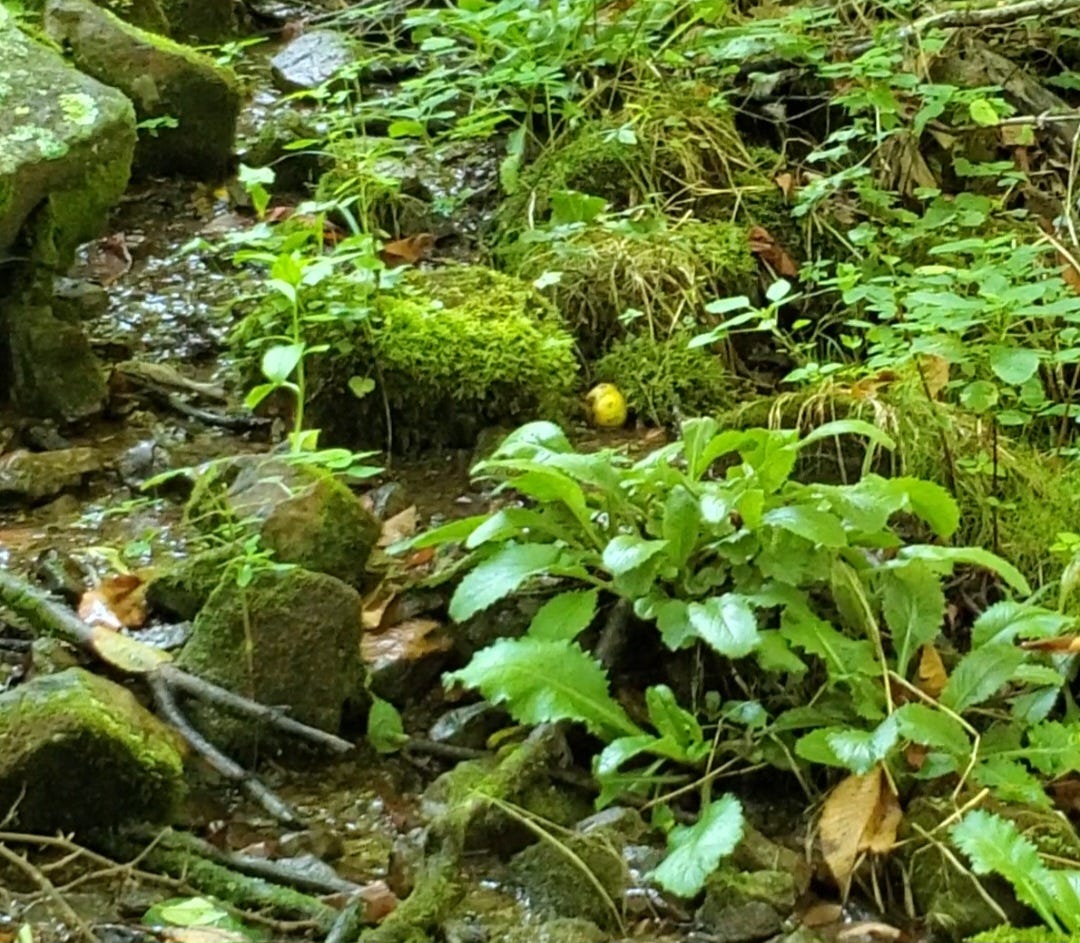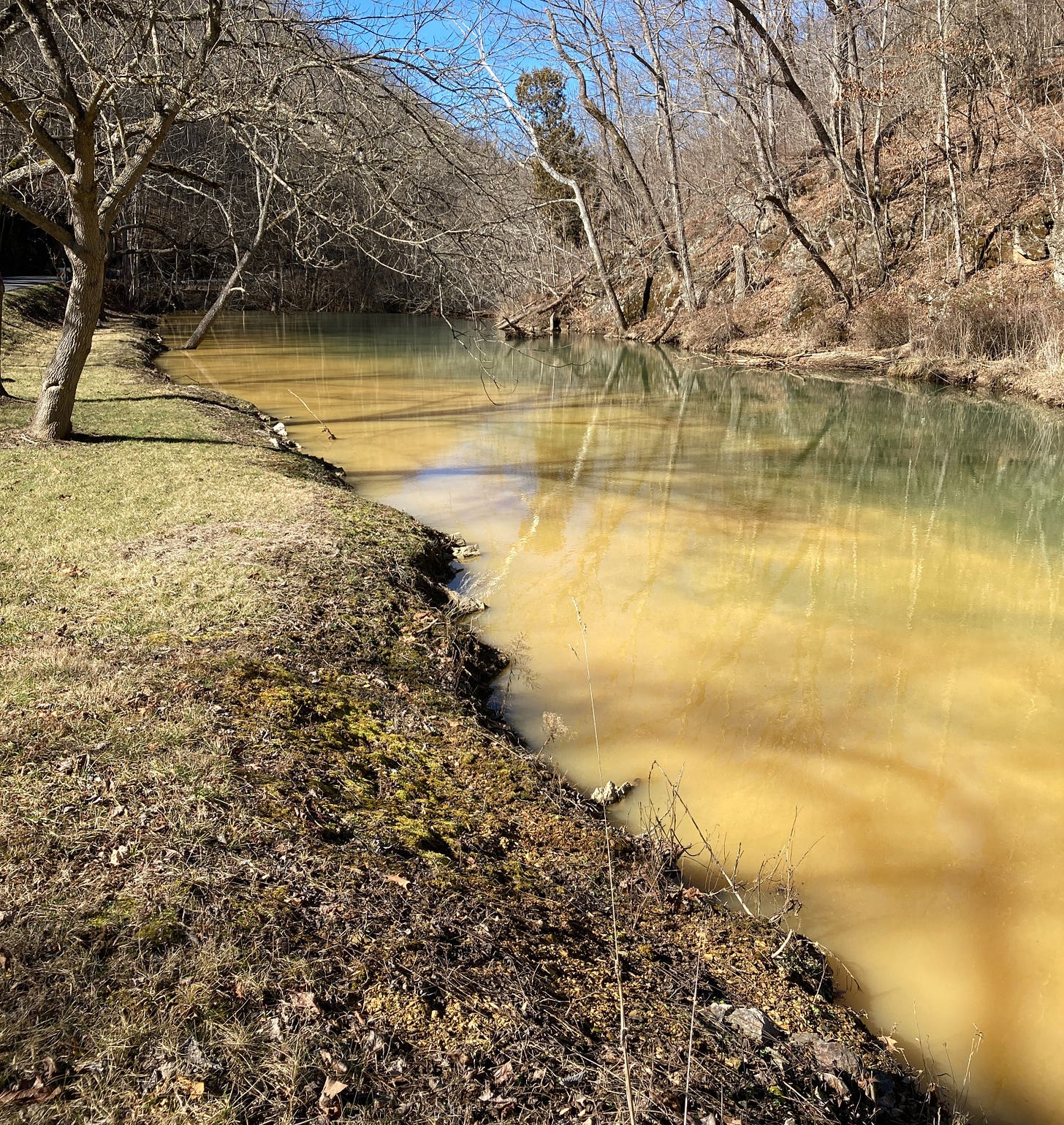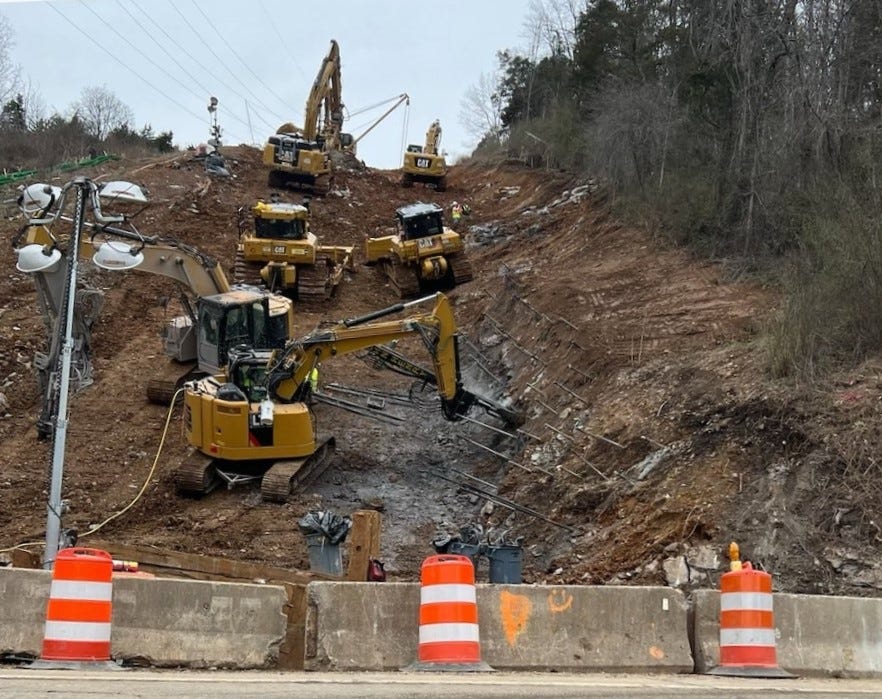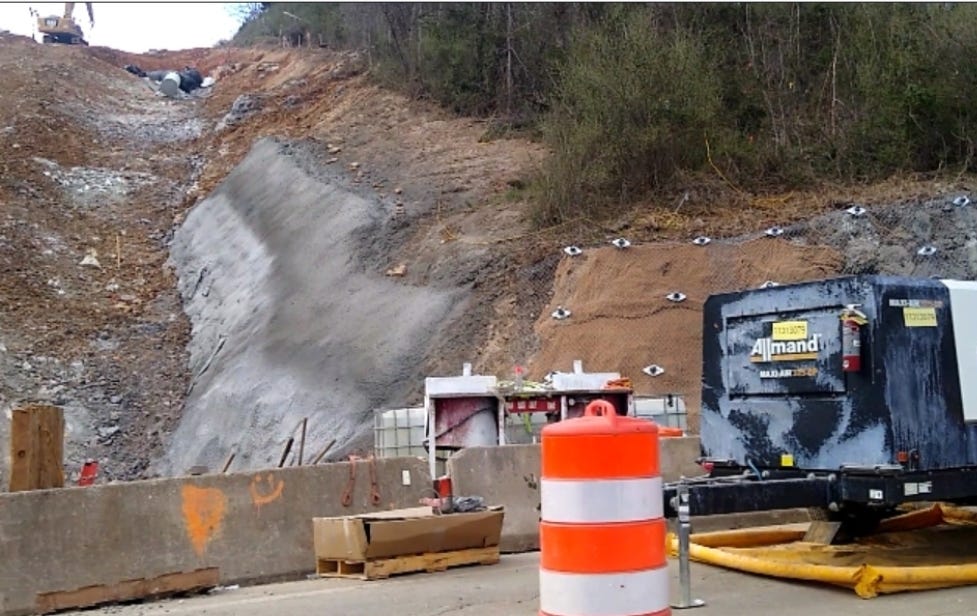The extent of the Mountain Valley Pipeline’s impacts along its 303 mile length and 125’ construction corridor width are difficult to fully grasp. Some people realize the extent of these impacts more fully than others. Nan Gray is one of the few who know the depths of these impacts. As a soil scientist, Nan studies the interrelationships of soil, plants and the larger environment. Of the five soil scientists who live in southwest Virginia in proximity to the MVP, who know the area’s soils best, none of them were consulted about the project.
A licensed professional soil scientist in both Virginia and North Carolina, Nan sees soil as a living organism. Disturbances upset the delicate balances that allow soil systems to thrive. ‘Soils provide the food, water and home for biodiversity. Soils complete the undisturbed landscape,’ she explains. MVP’s disturbances have destroyed the living soils, creating an industrial wasteland – a dead zone planned to be kept cleared - that fragments the forests and affects forest creatures for miles on either side of the right-of-way. When disturbed, micro organisms die. Nan explains, ‘When soil is severely disturbed, soil microorganisms and organisms die, which gives other soil microorganisms a boost in population, until they die and there is nothing to replace them.’ This wasteland will stay a wasteland.
Nan has lived in Craig County, Virginia, close to the Giles County border for 30 years, studying the ancient soils here. She marvels at the history contained in the ground, in these rare and endangered places, which took millions of years to create. She’s charted living treasures that are the soils in the local national forests, distinct worlds unto themselves, sometimes teeming with life, sometimes quiet. She’s studied ephemeral ponds here, connected and unique wetlands with specialized amphibians that traverse the ponds only during specific climate events. In some areas, she has documented organic matter 13” deep in wetlands – each inch of which took thousands of years to create. Within these ancient wetlands is a record of life on earth, micro-ecosystems with their own evolutionary history and a refuge for lifeforms found nowhere else. Wetlands are some of the most endangered ecosystems on the planet, critical to remove sediment from waterways, and pollutants from the atmosphere. They hold plants in place, and slow the flow of water. One acre of wetlands can absorb 1.5 million gallons of water.
Soil scientists perform soil surveys to inventory the types of soils in an area before work begins, to gauge the suitability of a site for a project. Virginia has about 500 different soil types, definitely not a ‘one size fits all’ situation. A 1985 soil survey of Giles County revealed problem-prone soils, with most having multiple problem-prone characteristics. These soils are typical of those found in karst terrain – the fragile dissolved limestone structures that produce caves and spontaneous sink holes. Another characteristic of karst soils is its high shrink/swell potential, meaning they shrink and crack when dry, and swell when wet, fluidity known to crack foundations because of the movement of the soil.
But the MVP probably didn’t understand these soils. Notably, the MVP did not perform an ‘Order One’ soil survey here, which would have defined the entire route, including Indigenous sites that MVP is likely to have destroyed. The 1985 survey documents the presence of many ‘Frederick’ or ‘Carbo’ soils here, both formed from the limestone bedrock and are well drained, slowly permeable and possess high shrink/swell potential.

The MVP route snakes continuously and frequently in and out of these Carbo soils. Nan vividly describes the impossible mechanics of putting a rigid pipe in incompatible Carbo soils: every time pipe wiggles, the chance of pipe failure increases. Pressure changes at a compressor station, or a kickback from a pump will cause the pipe to move, creating voids in the surrounding soil. This pipeline’s valves allow the gas to flow in either direction, so changing the flow within the pipe will cause dramatic sudden changes in the pressure within. Voids within the karst are one of the defining characteristics of the terrain, and are known to spontaneously appear even without disturbances like pipeline construction. They’re a feature of most of the soil in much of the pipeline’s 303 miles.
Seventy-five percent of the MVP route is in ‘multi-problem prone’ soil - unsuitable soils – soils that are known to fail when trenched. The actual proportion of unsuitable soils may be higher, since MVP chose not to have the route mapped, and no expert soil scientist reviewed the route. For a project this massive, that oversight is inexcusable. As Nan explains, ‘Every time a slope changes, the soil changes.’ MVP ignored the fact that these soils are alive, and are constantly in motion – facts that make this pipeline the ticking time bomb it is.
Although the Natural Resources Conservation Society (NRCS) provided MVP with detailed soil information for both VA and WV, MVP either couldn’t interpret the information, or ignored the facts, or both. The two states’ soil charts use different symbols, which perhaps stymied the MVP. The Pipeline & Hazardous Materials Safety Administration (PHMSA) advised MVP to avoid the area, advice MVP ignored. Karst specialists were silenced for the sake of pushing the project through, no matter what science dictated. Karst’s inherent confined spaces can collect dangerous gasses within the voids.
From the NRCS’s soil survey manual, ‘Soil that is disturbed/transported/moved/eroded and then deposited in water is called sediment. Soils are rated by how likely they are to erode. That means highly erodible soils are expected to become sediment if disturbed.’ Additionally, ‘Without sound information about a soil in its undisturbed state, any attempt at erosion control calculations is useless for specific problem sites.’ This area is known for its highly erodible soils. The pipeline was a disaster from the start, as soil scientists knew.
Other inconsistencies include the proximity of the pipeline route to the Nature Conservancy’s Canoe Cave, just one mile down gradient from the right-of-way. Because of the inter-connectivity of the caves and channels within the karst, pipelines are typically not allowed within 5 miles of protected caves. Without a preliminary soil survey, MVP can’t know what’s on the route.
On the southeast side of the elevated Sinking Creek plateau, close to the Giles/Craig county line, is Sinking Creek Mountain. The MVP route traverses this mountain, on slopes of 60 degrees and greater. The mountain includes the Saltville Fault, an indication of this ever-shifting landscape. Seismic events aren’t uncommon here. Five occurred in one month last summer.
Huckleberry Knob, on the eastern side of Sinking Creek Mountain, was the site of eastern North America’s largest rockslide. Unsurprisingly, soils on Sinking Creek Mountain are also identified as ‘problem soils.’
MVP construction included blasting a notch at the top of Sinking Creek Mountain. Last winter, Nan trekked to the top to survey the scene to find 20’ ice floes emanating from a newly blasted open crevice, from which a continuous stream of water gurgled, exposing previously potable water to the atmosphere from a formerly untapped aquifer. The new stream channels water down both sides of the mountain over MVP’s freshly disturbed soil, creating new landslides as the water freezes, trickles, freezes again, and melts again.
Also close to the Giles/Craig county border is the site of one of MVP’s worst disasters. Before the MVP, Sinking Creek was a stunning beauty of a waterway, a pristine trout stream with 6 other species of fish inhabiting its clear waters. Pre-eminent geologist Ernst Kastning predicted a pipe crossing at Zells Mill, beside a 1916 covered bridge, would be impossible, since the underground aquifer within the karst lies so close to the surface. Although it was no surprise, it was nonetheless tragic when a succession of 4 sediment pollution events occurred here from November of 2023 through February of 2024.
In one of the pollution events, the stream bed was punctured by the drilling operation. Trained water quality monitors dutifully reported these catastrophic events, each followed by days of sediment flowing freely into the creek. The VA Dept of Environmental Quality methodically closed each report, either citing no issues with the erosion control devices, or that the sediment release had stopped, ignoring the obvious presence of sediment plumes. One of these plumes lasted 2 weeks and reached a length of 5 miles. No violations were issued, no inspectors promptly appeared on scene to investigate. The pristine waters and rich habitat for aquatic creatures are no more.
It was recently revealed new DEQ director Rolband formerly headed an environmental consulting firm that contracted for the MVP. Under Rolband’s helm, very few violations and fines have been issued to the MVP. Since the resumption of construction last summer, MVP has received 2 notices of violation and fines totaling $2500. In its previous round of construction, they were issued more than 350 violations and over $2 million in fines. It’s estimated that MVP’s true tally of violations is closer to 1500.
In mid-February, the foot of the slope uphill from these sediment disasters collapsed. A landslide on the same slope occurred. Sharp rocks lay on top of the pipe in the trench, compromising the already-compromised pipe coating that had spent years beyond industry recommendations outside in the elements. Observers witnessed workers filling the trench with cement, then reinforcing the slope with spikes. The last fix appears to be a coating of concrete on the landslide area. Nan’s assessment: ‘That will not hold.’
Onsite, Nan observed rock streaked with clay. Clay moves through rock at every crack & accumulates when it slows down. Every face is coated, which lubricates the rock, helping it stay in motion. Clay absorbs water, exerting 1500 lb of pressure per sq inch. Rocks and soils do stay in motion, with these many forces working on them, just as soil science foretold.
MVP’s engineering techniques in these problem soils amount to putting a finger in a hole of a dike. The movement of the soil, which constantly migrates through cracks in rock cannot be stopped without magically changing the laws of nature. Clay particles align to look like a smooth face of the soil. The soils absorb water and expand, to create that shiny surface and make a slow but constant creep over millions of years, sometimes suddenly giving way when the burden of water becomes more than soil can hold. With MVP’s ignorance and dismissal of soil science, they have created in Nan’s eyes a series of ‘sloppy, repeatable patterns of expected messes.’
State environmental agencies offer no protection against extractive industries’ questionable practices. Virginia’s state Attorney General could have pressured the DEQ to issue a stop work order while Sinking Creek was being actively polluted for months. The AG’s office could not be reached despite multiple groups’ months-long attempts. VA’s State Water Control Board heard testimony from 6 individuals at their meeting 3 weeks ago about the ongoing sediment events at Sinking Creek and elsewhere. The large photos that were brought to the meeting to illustrate the extent of the crisis weren’t allowed to be shown. After the testimonies - the only public comments presented at that meeting - the Board immediately adjourned without questions or promises to act. These communities have been abandoned.
This has been the saga of Appalachia for ages. Extractive industry has decimated the landscape and communities.Examples are everywhere here: Two counties in southern West VA had been without potable water for more than a year, due to contamination of the area’s water supply by extractive industry. ‘Independent tests show lead, arsenic, and aluminum levels hundreds of parts per billion over the legal safe limits. Local residents have had stream water tested to reveal the water has surfactants in it-- an industrial chemical used to separate coal from impurities,’ a fundraiser for the affected community states.
EQT, the mothership of the company building the MVP, continues to increase its presence in the Appalachian Basin. This company makes a lousy neighbor. Its business model of poisoning and decimating communities, enabled by regulators and state agencies that would rather look the other way than take on the largest gas producer in Appalachian Basin.
When industry abandons a community, harms continue from the damage that’s been wrought, such as this WV community that’s physically sinking into collapsed mines underground. Who’s left holding the bag when the big companies leave? Should construction stop tomorrow, the devastation that’s been wrought can’t be erased. These harms will last generations and longer.
In Nan’s knowing eyes, she sees the killing details in the pipe being laid in trenches – 4 different shades of green, scratched protective coating, rusty welds, sharing a ditch filled with sharp rocks. She watches MVP perform repair after repair after repair, patching their mistakes again and again, demonstrating their ineptitude. ‘How do people not feel a damn thing?’ she queries. She’s haunted by the devastating magnitude of the tree felling, and the relentless digging, disturbing the all-precious living entities that are these old soils. She’s now propagating blueberry bushes, creating new life, not knowing if her efforts will work, but trying nonetheless. She feels betrayed by her neighbors who took money from the MVP, and also considers her farmer neighbors who aren’t available to oppose the pipeline. ‘They have the most to lose,’ she reckons.
As Nan surveys the 125’ cleared right of ways, traversing mountain after mountain out into the distance, she mourns the millions of trees taken before their 200 – 300 year life expectancy. The waste is staggering. These sentinels are the forces that ‘stabilize the forests and the soils they’ve killed’ in her eyes. She’s cursed with a knowledge of the depth of the toll here, including the myriad sacrificed unmapped ephemeral ponds buried under landslides. ‘They came and destroyed what I love. I love it here. How am I supposed to care for my mutilated land? They’ve destroyed a sacred place.’
The abdication of responsibility of all who could have prevented this catastrophe is keen to her. ‘We’re not supposed to be the ones looking after our safety.’
~~~~~~~~~~~~~~~~~~~~~~~~~~~~~~~~~~~~~~~~~~~~~
Please donate to the legal defense fund for pipeline fighters: bit.ly/AppLegalDefense. Protectors face ever-increasing and expensive intimidation tactics and legal charges, but remain undaunted.
The worthy on-the-ground groups fighting the disaster spelled MVP. Please support them, if you are able:
https://www.aapsolidarity.org/
https://powhr.org/
https://7directionsofservice.com/












Thanks Deborah, what a kick ass article. Nan Gray is fabulous
You are such a fabulous writer Deborah, thank you for sharing your talent with us
Deborah Kushner tells a story that is easy to follow. Which is saying a lot considering how complex the whole picture is -- the complexities of various regulations and how they are blatantly defied, and the pertinent science as she spoke with Nan Gray, the soil scientist who clearly told us what consequences are and will continue to happen. This writer needs a wider audience.